Centenary of the Holywood and District War Memorial
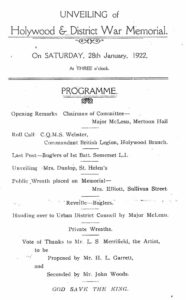
Wreath Ceremony 1922
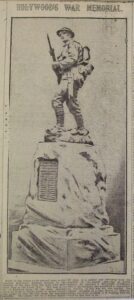
Model (Belfast Telegraph Aug 1919)
On Saturday 28th January 1922, the Holywood & District War Memorial was unveiled.
The decision to proceed with the erection of a war memorial to commemorate fatalities from Holywood and District was taken at the Town Hall on 15th August 1919. Mr Leonard Stanford Merrifield of Chelsea provided a model of the memorial. In 1919, 150 subscribers had promised £725 and it was thought that the total cost would be £900, which equates to £47,500 in current terms.
The memorial was erected on a parcel of open ground between Holywood Railway Station and Holywood Orange Hall. The plot had been purchased for this purpose by Mr David Alfred Fee JP, who donated the plot to Holywood Urban District Council.

Site Preparation (Belfast Telegraph Nov 1921)
Site preparation work commenced in November 1921. The rugged Portland Stone base of the memorial was nine feet and six inches tall and the bronze statue of the soldier in full war kit in “On Guard” position was six feet high.
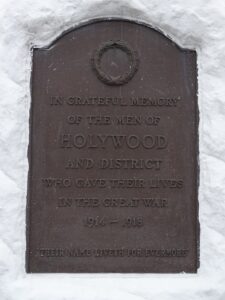
Dedication Panel
Company Quartermaster Sergeant Wilmot Webster, Commandant of the Holywood Branch British Legion, read out the names of the 109 men commemorated on the memorial, the announcement of each name being followed by a muffled drumbeat. Wilmot Webster of High Street in Holywood was a 42-year-old married man with three children when he enlisted with the 6th Battalion Connaught Rangers on 14th November 1914. He held the rank of Acting Quartermaster Sergeant when he was deployed to France with 16th (Irish) Division in December 1915.

Extra Name (S Patterson)
He was serving with the Labour Corps when he was transferred to the Class Z Army Reserve on 10th April 1919. He subsequently received a pension for deafness attributable to his war service and rheumatism and arthritis aggravated by war service. He died on 1st January 1926, aged 52, and is buried in Holywood Cemetery.
An additional name was added in 2011. Samuel Potter, who served as Patterson, was killed in action on 14th September 1914 during the Battle of Aisne whilst serving with 2nd Battalion Connaught Rangers. Amongst the names commemorated are a recipient of the Victoria Cross, three men awarded the Military Cross and two men awarded the Military Medal.
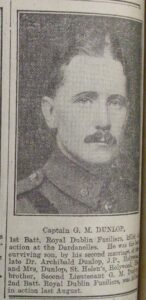
George Malcolm Dunlop
The memorial was unveiled by Mrs Bessie Dunlop of St Helen’s in Holywood, the widow of Dr Archibald Dunlop. She said, “I feel honoured in being asked to unveil this beautiful and striking monument, erected to the memory of our fellow-townsmen, who gave their lived for King and Country. I am one of those who suffered a double loss among them. I think my eldest son was, of those we commemorate today, the very first to fall.”
John Gunning Moore Dunlop was born on 14 December 1885 and received his commission from Cambridge University Officers Training Corps in September 1910. He was gazetted to the Special Reserve of Officers for the Royal Dublin Fusiliers in June 1911. He was deployed to France with 2nd Battalion Royal Dublin Fusiliers, disembarking at Boulogne on 22nd August 1914. He was Killed in Action five days later near Clary during the Battle of Mons at the age of 28.
George Malcolm Dunlop was born on 13th January 1889, received a commission with the Royal Dublin Fusiliers in 1909, and held the rank of Captain in December 1914. He was killed in action with 1st Battalion at the age of 26 during the calamitous landing at Cape Helles on the Gallipoli Peninsula on 25th April 1915.

Mary Elliott laying Holywood wreath
The Public Wreath was laid by Mrs Mary Elliott of Sullivan Street who lost three sons in the Great War.
Private William Robert Elliott was serving with 2nd Battalion Royal Inniskilling Fusiliers when he was killed on 26th August 1914 during the retreat from Mons at the age of 32.
Lance Corporal Joshua Elliott was serving with 13th Battalion Royal Irish Rifles when he was killed by shell-fire during heavy enemy bombardment on 4th August 1917, at the age of 30.
Sergeant Francis James Elliott was serving with 2n Battalion Royal Irish Rifles when he died of wounds on 7th August 1917 at the age of 28.
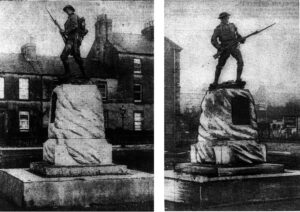
Holywood War Memorial (Belfast Weekly Telegraph, Feb 1922)
The Dunlop brothers and the Elliott brothers are also commemorated on the memorial tablet in Holywood Parish Church.
David Alfred Fee, Chairman of Holywood Urban District, said,
“I have the melancholy pleasure of accepting, on their behalf, as custodians of the ratepayers, the statue just now unveiled, which will remind future generations of the heroic deeds of the gallant sons of Ulster who went out voluntarily in response to their country’s call to fight in the spirit of their forefathers for liberty and freedom”.
David Alexander Fee was to suffer personal loss in the Second World War when his son, Lieutenant Thomas Hugh Cecil Hickland Fee, Royal Naval Reserve, was Killed in Action on 23rd November 1939, aged 28, whilst serving on HMS Rawalpindi.

HMS Rawalpindi

Holywood Trophy Gun (Larne Times, July 1924)
From July 1924, the memorial was flanked by two German guns that had been awarded to Holywood as war trophies.
From examining old newspaper images and postcards, the memorial has been moved twice in the past 100 years. It was originally position in the middle of the square closer to the Orange Hall and protected from traffic by railings. Later, four sturdy stone bases were set in place to support light fittings. Later still, the memorial was moved closer to the shoreline and there was talk of turning it around so that the people attending on Remembrance Sunday would not be facing the back of the memorial.

Holywood War Memorial
There was local opposition to this as the soldier was deemed to be protecting the town from seaborne attack. In recent years, the memorial was moved to its current position and the rugged Portland Stone base replaced by a dressed stone base.
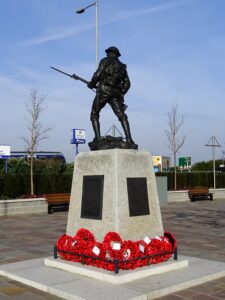
Holywood War Memorial
They shall grow not old, as we that are left grow old:
Age shall not weary them, nor the years condemn.
At the going down of the sun and in the morning
We will remember them.
Nigel Henderson
History Hub Ulster Researcher

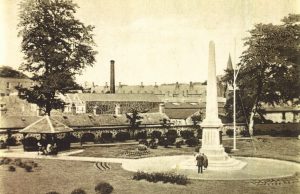


 The youngest fatality was only 17 years old. Rifleman David Martin, Royal Irish Rifles, was Killed in Action on 17th June 1916 and is buried in Authuile Military Cemetery in France. He was born on 27th April 1899 at Ballynahinch Road to David Martin and Annie Singleton.
The youngest fatality was only 17 years old. Rifleman David Martin, Royal Irish Rifles, was Killed in Action on 17th June 1916 and is buried in Authuile Military Cemetery in France. He was born on 27th April 1899 at Ballynahinch Road to David Martin and Annie Singleton.

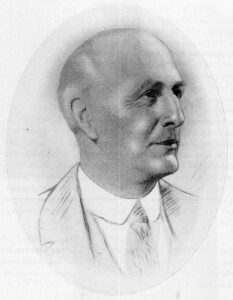
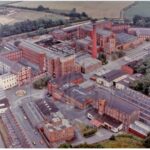
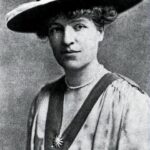
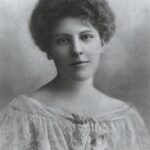

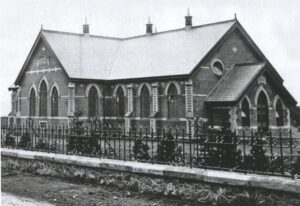
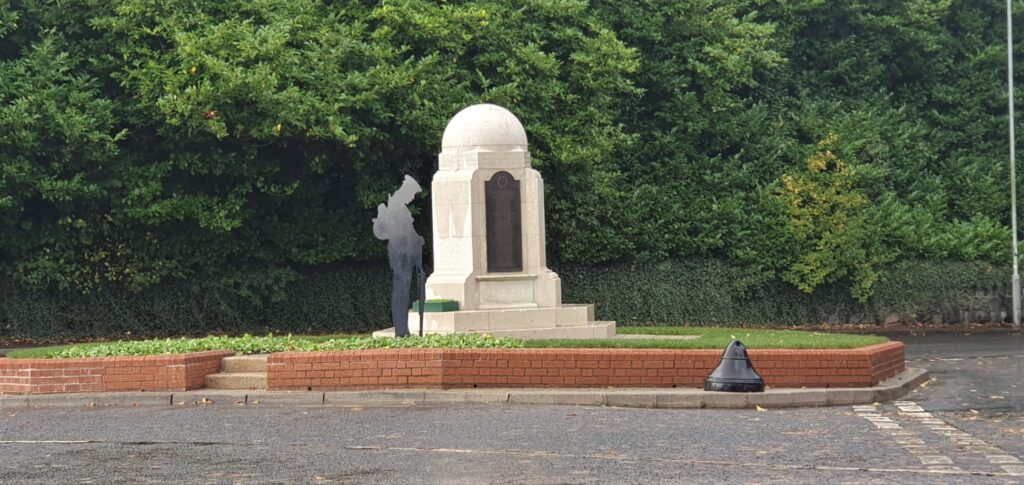
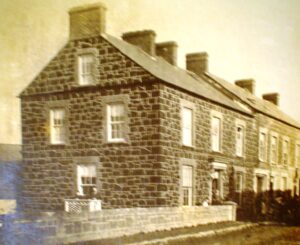 Whilst undertaking research into the Northern Bank in Bushmills, I came across a sad tale about the first branch manager of the Belfast Bank branch in that small village. In 1870, Thomas McComb (32) had been working in the Belfast Bank, Coleraine branch as Accountant and Cashier for 13 years when he was appointed Manager of their Bushmills Agency. He was widely respected in the town. This article presents the sad story of Thomas McComb through newspaper clippings and photographs.
Whilst undertaking research into the Northern Bank in Bushmills, I came across a sad tale about the first branch manager of the Belfast Bank branch in that small village. In 1870, Thomas McComb (32) had been working in the Belfast Bank, Coleraine branch as Accountant and Cashier for 13 years when he was appointed Manager of their Bushmills Agency. He was widely respected in the town. This article presents the sad story of Thomas McComb through newspaper clippings and photographs.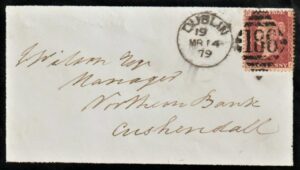 An old envelope addressed to ‘J Wilson, Manager, Northern Bank, Cushendall’ and postmarked ‘Dublin 19, 14th March 1879’ was recently discovered in an internet search. What is the story of this bank branch in the small County Antrim village of Cushendall? This article presents the history of the building through newspaper clippings and photographs.
An old envelope addressed to ‘J Wilson, Manager, Northern Bank, Cushendall’ and postmarked ‘Dublin 19, 14th March 1879’ was recently discovered in an internet search. What is the story of this bank branch in the small County Antrim village of Cushendall? This article presents the history of the building through newspaper clippings and photographs.
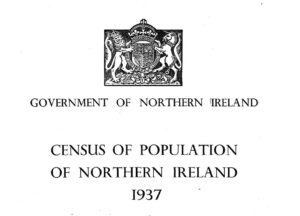 In order to bridge the gap between the census of 1926 and the census which it was intended to take in 1941, a census of more limited scope (e.g., omitting questions regarding occupation and industry) was taken in 1937. The returns were made as at midnight of 28th February – 1st March, 1937, and a Preliminary Report, containing population and other tables, was issued in July of that year.
In order to bridge the gap between the census of 1926 and the census which it was intended to take in 1941, a census of more limited scope (e.g., omitting questions regarding occupation and industry) was taken in 1937. The returns were made as at midnight of 28th February – 1st March, 1937, and a Preliminary Report, containing population and other tables, was issued in July of that year.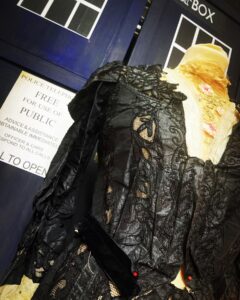
 “I wonder can anyone help me with some research pointers for this dress – it carries the label James Lindsay &Co Ulster Arcade which I believe is the Lindsay Brothers – Thomas Lindsay, Mayor of Belfast in 1875? I know they were textile merchants (and very successful too) but I don’t know if they actually produced/commissioned clothing? Any info about the company very welcome”.
“I wonder can anyone help me with some research pointers for this dress – it carries the label James Lindsay &Co Ulster Arcade which I believe is the Lindsay Brothers – Thomas Lindsay, Mayor of Belfast in 1875? I know they were textile merchants (and very successful too) but I don’t know if they actually produced/commissioned clothing? Any info about the company very welcome”. James Lindsay and Co was established at 18 Donegall Place, Belfast c 1860. The Lindsay family first came to Ireland from Scotland in 1678, with their descendants moving to Belfast in 1822, opening a “woollen, linen and haberdashery warehouse” trading as J & D Lindsay on Bridge Street. The business prospered and John and David Lindsay brought into the partnership their three younger brothers, one of whom was James Lindsay after which the business at 18 Donegall Place was named.
James Lindsay and Co was established at 18 Donegall Place, Belfast c 1860. The Lindsay family first came to Ireland from Scotland in 1678, with their descendants moving to Belfast in 1822, opening a “woollen, linen and haberdashery warehouse” trading as J & D Lindsay on Bridge Street. The business prospered and John and David Lindsay brought into the partnership their three younger brothers, one of whom was James Lindsay after which the business at 18 Donegall Place was named.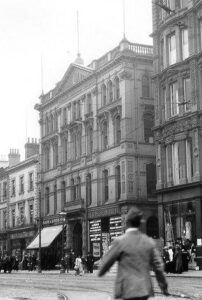 James Lindsay & Co was part of a much larger family business which traded under the name Lindsay Brothers. They first began manufacturing muslin in the early 1800s, but expanded the business to include the spinning of flax at two large mills (the Mulhouse Works and Prospect mills) and all associated processes involved in the rapidly developing linen industry. These goods were exported all over the world from their warehouse at 7-9 Donegall Place (see pic). This building still stands as the Disney Store today.
James Lindsay & Co was part of a much larger family business which traded under the name Lindsay Brothers. They first began manufacturing muslin in the early 1800s, but expanded the business to include the spinning of flax at two large mills (the Mulhouse Works and Prospect mills) and all associated processes involved in the rapidly developing linen industry. These goods were exported all over the world from their warehouse at 7-9 Donegall Place (see pic). This building still stands as the Disney Store today.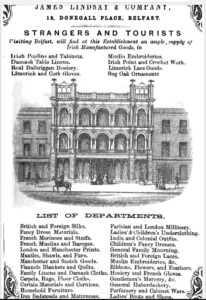 The business continued to prosper for the next 80 years, and allowed James to reside at a large house and estate called “Wheatfield” at Ballysillan, North Belfast. The business concentrated on products of Irish Manufacture, and they were soon joined by other worldwide concerns such as Robinson & Cleaver which opened their Royal Irish Linen Warehouse two doors up on Donegall Place in 1888 – the year Queen Victoria granted Belfast it’s charter as a city.
The business continued to prosper for the next 80 years, and allowed James to reside at a large house and estate called “Wheatfield” at Ballysillan, North Belfast. The business concentrated on products of Irish Manufacture, and they were soon joined by other worldwide concerns such as Robinson & Cleaver which opened their Royal Irish Linen Warehouse two doors up on Donegall Place in 1888 – the year Queen Victoria granted Belfast it’s charter as a city. 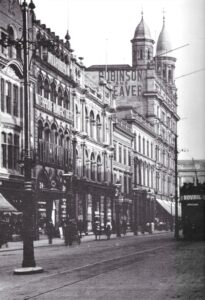

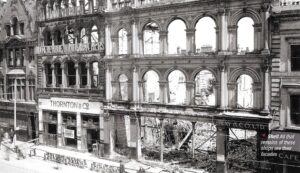
 When the building was destroyed, Thomas Brand merged with Norman & Co on Castle Lane to form Brands & Normans. The Brand family also developed Brands Arcade (aka Birdcage Walk) becoming one of the most important fashion houses and retailers in Belfast in the “Swinging Sixties” Sadly that business has now also disappeared from the streets of Belfast, as has C&A, Robinson & Cleaver, Anderson & McAuley and all the other great stores, even up to last month when Debenhams closed down.
When the building was destroyed, Thomas Brand merged with Norman & Co on Castle Lane to form Brands & Normans. The Brand family also developed Brands Arcade (aka Birdcage Walk) becoming one of the most important fashion houses and retailers in Belfast in the “Swinging Sixties” Sadly that business has now also disappeared from the streets of Belfast, as has C&A, Robinson & Cleaver, Anderson & McAuley and all the other great stores, even up to last month when Debenhams closed down.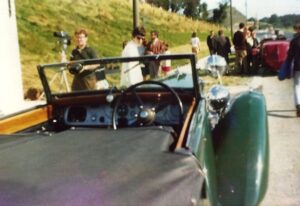 The history of Northern Ireland isn’t always about politics; it’s about people and sporting achievements too. Between 1928 and 1936 the RAC (Royal Automobile Club) ran the
The history of Northern Ireland isn’t always about politics; it’s about people and sporting achievements too. Between 1928 and 1936 the RAC (Royal Automobile Club) ran the 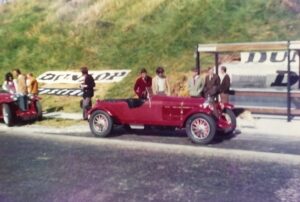 Gavin’s photographs, a few are shown here, feature in a short video uploaded to the
Gavin’s photographs, a few are shown here, feature in a short video uploaded to the 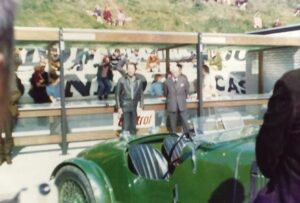 The memorial is in the form of a reconstruction of three of the pit ‘units’. These have been erected on the site of the original pits, close to the Rolls Royce factory outside Dundonald. Built of wood, the 10ft long structures were used by pit staff during races.
The memorial is in the form of a reconstruction of three of the pit ‘units’. These have been erected on the site of the original pits, close to the Rolls Royce factory outside Dundonald. Built of wood, the 10ft long structures were used by pit staff during races. Archibald McIlroy of Drumbo was a stockbroker and Justice of the Peace who had emigrated to Canada with his wife to work as missionaries. Archibald was a published author in the Kailyard style, late 19th-century movement in Scottish and Ulster Scots writing that was characterised by a sentimental idealisation of humble village life. His novels captured the ethos of rural life, particularly from a Presbyterian perspective. Among his novels were When Lint was in the Bell, The Auld Meetin’ Hoose Green (1898), The Banker’s Love Story. Archibald and Anna McIlroy sailed in Second Class and Archibald, who was 55 years old, is commemorated on the war memorial tablet in Ballycairn Presbyterian Church, Ballylesson. Anna Caroline McIlroy died in Toronto on 21st July 1942 at the age of 77.
Archibald McIlroy of Drumbo was a stockbroker and Justice of the Peace who had emigrated to Canada with his wife to work as missionaries. Archibald was a published author in the Kailyard style, late 19th-century movement in Scottish and Ulster Scots writing that was characterised by a sentimental idealisation of humble village life. His novels captured the ethos of rural life, particularly from a Presbyterian perspective. Among his novels were When Lint was in the Bell, The Auld Meetin’ Hoose Green (1898), The Banker’s Love Story. Archibald and Anna McIlroy sailed in Second Class and Archibald, who was 55 years old, is commemorated on the war memorial tablet in Ballycairn Presbyterian Church, Ballylesson. Anna Caroline McIlroy died in Toronto on 21st July 1942 at the age of 77.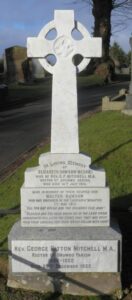
 A Typist
A Typist A Photographer
A Photographer